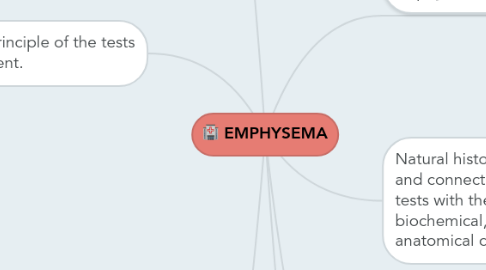EMPHYSEMA
von Rodrigo Mejía Luna

1. Emphysema: It's a chronic obstructive pulmonary disease (COPD) where the alveoli are damaged. As a result the body doesn't get the oxygen it needs. Emphysema makes it hard to catch his breath. It can also cause chronic coughing and breathing difficulties during exercise. The most common cause is smoking.
1.1. It is chronic because the treatment may slow the progress of emphysema, but it can not reverse the damage into the alveoli. The destruction or damage into the alveolus makes breathing difficult, emphysema also destroys the elastic fibers that cause can not enter or leave air.
2. Name and principle of the tests done to patient.
2.1. A1AT test : Helps diagnose alpha-1 antitrypsin deficiency as the cause of early onset emphysema, especially when a person does not have obvious risk factors such as smoking or exposure to lung irritants. This test was the first test performed to the patient, because at a time they don’t knew he smoked.
2.2. Pulmonary function tests or Spirogram: It is a set of tests that measure the ability of the lungs to inhale and exhale air, this test is carried out through an instrument called a spirometer, example :
2.3. Lung diffusion testing or DLCO test : This test measures how well oxygen moved through the lungs and the bloodstream . The person has to inhale air which contains an amount of tracer gas, then hold your breath for 10 seconds and then exhale very fast. After the amount of tracer gas is absorbed during the breath is analyzed.
2.4. Chest x- ray or Chest radiography: This test is used to visualize the lungs, with which the doctor can observe the alterations made to lung emphysema as: Horizontalization ribs, depressed diaphragm and extended intercostal spaces.
2.5. Thoracic CT or Chest CT: The high-resolution CT scan is used to determine how advanced pulmonary emphysema is and if it requires surgery.
3. Which were the tests that confirmed the diagnosis? We believe it doesn´t exist a specific test that confirmed the diagnosis, but the combination of all of them each test confirm different things for the resolution of this case, and for that all the tests were important for discovering of the final diagnosis: First the doctor had to do a Alpha - 1 antitrypsin test for know if the causes of the emphysema was a Alpha - 1 antitrypsin (The results were positives ), after that the doctor did a pulmonary function tests used to know by spirometry how much air axel can inhale and exhale, with this the doctor can determine the value of lung function, while Chest x-ray helped the doctor to observe the specific characteristics of pulmonary emphysema (horizontalization ribs, diaphragm depressed, more air in the lung), which help to rule out other diseases COPD. Lung diffusion testing helped to know which is the exchange of gases that exist in the lungs of the person.On the other hand. Finally for the doctor to know what was the rank of emphysema he was made to the patient a thoracic CT.
3.1. TREATMENT -To have rest and stop smoking. -It should be treated promptly infection of the airways and strengthen the respiratory muscles through physical therapy. -Use of inhalers, oxygen and some medication like: bronchodilators to reduce muscle spasm and drink plenty of water to avoid dehydration, but if they don't serve , it would be necessary a surgery or lung transplantation.
4. •An 18-year-old adolescent •Purple nail and lack of oxygen •Has trouble breathing •Went to the nursery and the nurse told him to rest •After some the days continue going he felt worse couldn’t recover the breathing, not even when he was resting •He sometimes smoked at parties, but his father smokes everyday •He went to the doctor’s office, and the doctor told him that he had emphysema •He knew this because of the five tests results were: •A1AT test which showed that Axel is a passive smoker •The DLCO test which revealed why Axel´s nails were purple(due to the lack of oxygen) •The Spirogram that shows he had struggle breathing •The chest radiography revealed extended intercostal spaces and a depressed diaphragm •The chest CT that affirm that he had emphysema.
5. Natural history of this disease and connect the results of the tests with the molecular, biochemical, physiological and anatomical changes.
5.1. Molecular changes: The elastin that we have in the pulmonary alveoli is damaged because of chemicals that are inhaled and have oxidizing properties. Biochemical, physiological and anatomical changes: Biochemical: a burning cigarette emits over 7,000 chemicals, which are the ones that causes this disease, some of them are arsenic, lead, methanol, nicotine and many more dangerous chemicals Physiological: Airflow limitation amount of oxygen that reaches the bloodstream is reduced. Anatomical: reduction of the lung surface. Destroyed elastin (lack of protection to further damage) Lungs hyperinflation
6. Signs: -Purple lips and nails Symptoms: -Lack of oxygen -Struggle with breathing -Taquipnea -Cough -Fever -Thick mucus -Swelling of ankles
7. Recovery: -Because this is a long-term chronic disease you can not recover health at all but you can help your organism with oxygen tanks and inhalers in order to make your lungs work correctly.


